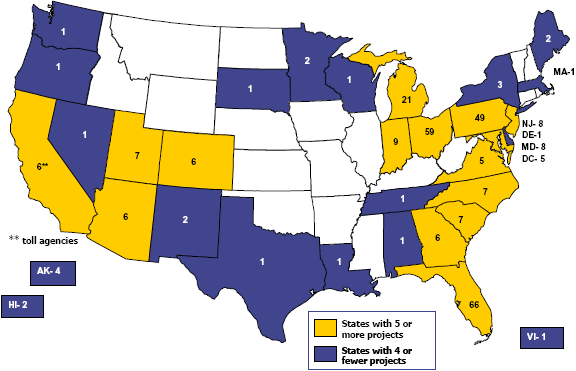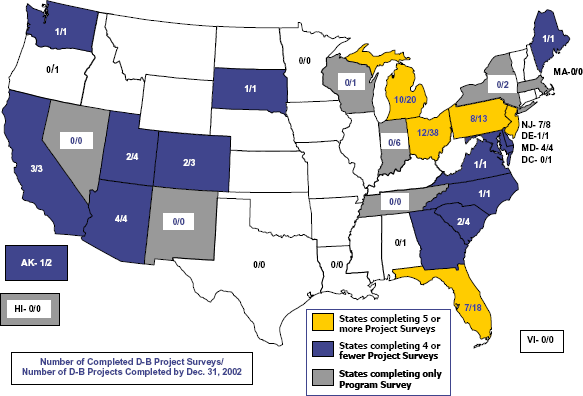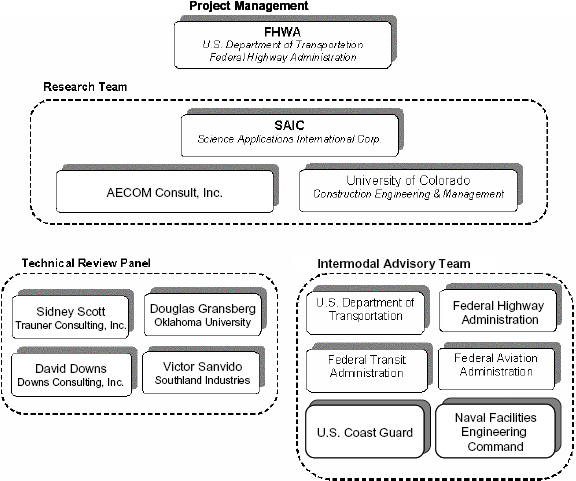| < Previous (Table of Contents) | Table of Contents | Next (Design-Build Project Delivery) > |
This introductory chapter presents an overview of the study effort, including study background, legislative basis for the study request, purpose and objectives, scope and methodologies, work plan, and research team.
During the 1980s and 1990s, State transportation agencies (STAs) across the nation attempted to bridge the gap between highway program resources and needs by seeking new funding sources and experimenting with alternative processes to expedite critical highway capital projects needed to support statewide mobility and economic development. Since 1990, a number of transportation agencies (as owners, sponsors or contracting agencies of highway projects) have been experimenting with a wide variety of innovative project delivery strategies aimed at lowering the costs and time to produce highway construction and rehabilitation projects, while maintaining or improving project quality. Such strategies include the leveraging of private sector strengths in design and construction engineering functions, delegation of responsibilities for materials testing and project inspection functions to contractors, streamlining the project development process, and applying innovative project delivery, procurement, and contract administration functions1, 2. Among these strategies, design-build (D-B) project delivery represents one of the most promising yet controversial methods for streamlining the project development function and potentially lowering project cost and duration while maintaining or improving product quality.
Design-build is a method of project delivery in which the design and construction phases of a project are combined into one contract, usually awarded on either a low bid or best-value basis3, 4. This is in marked contrast to the more traditional design-bid-build (D-B-B) approach applied by transportation agencies that outsource project design work, in which two different contracting efforts must be undertaken in sequence to procure architecture/engineering services on a negotiated-price basis and construction services on a lowest-responsible-bid price basis. In design-build, the engineering firm and construction contractor have the incentive to become an integrated team that works concurrently on the design and construction phases of different segments of a project, with the potential to expedite delivery and better control product quality and costs. Instead of separate procurement efforts for design and construction phases, design-build combines these two phases into a single procurement effort that may incorporate value-based award criteria - versus the traditional qualifications-based designer selection criteria and low bid-based contractor selection criteria.
Design-build contracting has become a popular form of project delivery for private firms and public agencies responsible for the development of buildings and other types of vertical infrastructure, spurred by the need to expedite project delivery in times of economic expansion and military build-up. By the end of the last decade, design-build contracting had grown to almost one-quarter of the total dollar volume of non-residential construction in the US, according to the Design-Build Institute of America. Much of this activity has been for vertical infrastructure (buildings), with the private sector most heavily committed to this form of facilities development contracting. In the future, further growth is expected in the following areas of public sector construction: transportation, corrections, education, and water/wastewater facilities.
While design-build project delivery is not new to the building construction industry, it is relatively new to the highway construction industry, whose roots are largely in the post World War II era when design-bid-build was already the established way to procure and deliver many types of infrastructure projects. Interest in the design-build approach by contracting agencies of highway projects has been spurred by reported successes achieved in applying this approach to project delivery by other infrastructure development sectors in this country (for buildings) and overseas (for buildings and highways)5, 6, 7.
In 1990, Special Experimental Project Number 14 (SEP-14) - Innovative Contracting, was established by the Federal Highway Administration (FHWA) to enable state transportation agencies to test and evaluate a variety of alternative project contracting methods that provided the potential to expedite highway projects in a more cost-effective manner, without jeopardizing product quality or contractor profitability. Between 1995 and 2002, about 300 projects amounting to $14 billion in costs were proposed for design-build contracting under the SEP-14 program by transportation agencies in 32 states, the District of Columbia, and the Virgin Islands8. This compares to only a handful that were proposed between 1990 and 1994. Exhibit I.1 shows the total number of design-build projects proposed, active, or completed in each state.
The results of projects undertaken in the early years of SEP-14 enabled FHWA to mainstream a number of innovative contracting approaches such as cost-and-time (A+B) based awards and the use of warranties in contracts to ensure product quality. However, the results of design-build projects proved inconclusive and controversial, with proponents and critics offering widely differing conclusions about the cost-effectiveness and equity of this alternative project delivery approach. As a result, A+B and lane rental contracting approaches became mainstreamed in 1995 while design-build contracting did not. Position papers by the major highway associations led FHWA to believe that the industry was not ready for wholesale deployment of design-build.

Source: Design-Build Projects Approved Under SEP-14, Federal Highway Administration, July 2003
In 1998, the Transportation Equity Act for the 21st Century (TEA-21) became the new authorization legislation for the nation's surface transportation programs. Included in TEA-21 was Section 1307 (f), which required that a comprehensive national study be conducted to evaluate the effectiveness of design-build contracting, with the results subsequently reported to Congress. While individual transportation agencies have evaluated a number of design-build projects under SEP-14, there has not been a comprehensive national effort to evaluate these projects on a uniform basis. This study attempts to fill that void and respond to Section 1307 (f) by focusing the data collection and assessment on completed design-build projects authorized under SEP-14. SEP-14 projects provide the most comparable sample of completed design-build projects that are pertinent to the Federal-aid highway program.
The purpose of this study is to report on the effectiveness of design-build contracting procedures in the Federal-aid highway program, as required by Section 1307 (f) of TEA-21. This section states:
To fulfill these study objectives, the analysis framework provides an objective basis for evaluating the impacts and implications of design-build contracting. The analysis framework defines the study scope and consists of the following attributes:
Consistent with the study purpose and objectives, as defined by Congress, the following outcome criteria are used to evaluate the cost-effectiveness of design-build project delivery:
These results were used to develop recommendations for improving the design-build procurement process and contract administration procedures.
The findings and conclusions presented in this report are based on a variety of fact-finding and analysis approaches, including:
A five-task work plan, shown as Exhibit I.2, was followed to develop the data inputs, perform the analysis, and generate the findings and recommendations that are contained in this report.

Source: AECOM Consult
A web-based interface was used to issue, receive, and process the surveys, with designated state participants accessing a secure website at the University of Colorado's School of Construction Engineering & Management to review, complete, and submit their survey responses. Having a secure study website enabled the research team to:
This is the first comprehensive study of design-build contracting to involve both program and project managers of transportation agencies who are directly responsible for Federal-aid highway projects delivered under this approach. The key findings presented by this report are based primarily on responses to three types of surveys provided by design-build program and project managers in agencies participating in the SEP-14 program. Data collection for the program/project analysis portion of the study spanned the six-month period from October 2003 through March 2004. This is the timeframe during which the survey instruments were issued to agencies expected to participate in the study, completed by designated design-build program and project managers, and returned for processing via the secure study website.
The following describes the three surveys and the numbers of each that were completed.
The program-level survey determined how transportation agency managers participating in the SEP-14 Program view the use of design-build for their projects. For the purposes of this study, all agencies with active design-build programs were asked to complete program surveys, even if none of their projects were completed by the end of calendar year 2002 (the end date for project consideration). This included those transportation agencies, toll agencies, or local public agencies with design-build programs (toll agencies or local public agencies administered design-build projects in California, New York, and Tennessee) - for a total of 32 states plus the District of Columbia. Of this total, 27 states (including two local toll agencies) and the District of Columbia completed the design-build program survey, for an 85 percent response rate.
The project-level survey was used to develop information on how design-build project delivery is used and its perceived consequences for a broad sample of SEP-14 projects completed before the end of calendar year 2002, as reported by agency managers responsible for these projects. A total of 282 projects made up the SEP-14 program for design-build projects by the end of 2002. Of this total, 140 projects had completion dates by the end of calendar year 2002. This group of completed design-build projects represented 24 out of the 32 states (plus the District of Columbia and the Virgin Islands) with design-build programs (71 percent of design-build states).
A sample of 86 projects out of 140 projects in the SEP-14 project database completed by the end of 2002 was selected for survey, representing 22 states and a broad cross-section of completed projects by type and size (a 61 percent sample). An upper limit of 12 projects per state was established to limit the amount of effort any one state would be expected to devote to this study's fact-finding process. Among the 22 states receiving design-build project surveys, 19 states submitted a total of 69 completed project surveys, representing an 80 percent response rate.
Given the modest number of design-build projects completed by the end of calendar year 2002, there is greater uncertainty in the results when the completed data sample is subdivided by state, project type, project size, or any number of disaggregating characteristic. Therefore, most of the survey results are presented in terms of the overall design-build program under SEP-14.
In addition to completing surveys for designated design-build projects, respondents were asked to identify a comparable project using the design-bid-build project delivery approach for each design-build project surveyed, where a truly comparable project could be identified. The project-level survey was also used to develop information on these similar projects delivered by the design-bid-build approach. This provided the opportunity to assess on a limited case-study basis differences in project performance between design-build and design-bid-build project delivery, including cost, duration, quality, and other factors related to competition and fairness.
This turned into a much more challenging effort than anticipated due to the difficulty in determining which projects could be considered comparable, identifying a knowledgeable person to complete the comparable project survey, and gaining the continued cooperation of respondents after completing the design-build program and project surveys. Consequently seven states submitted completed surveys for 17 design-bid-build projects. This represented 37 percent of the participating states and 25 percent of the design-build projects reported. Out of the 17 returned design-bid-build project surveys, 11 contained sufficient data to permit detailed analysis of project duration and cost by project phase. These results are reported in Chapter IV.
This is the first study to compare actual project results from similar pairs of projects, with one using design-build and the other using design-bid-build project delivery. Prior studies relied on comparisons based on actual results for design-build projects but only estimates of project cost and duration if delivered using the more traditional design-bid-build projects.
Exhibit I.3 shows the number of returned project surveys relative to the number of design-build projects completed by each state as of the end of calendar year 20029. Appendix D provides a detailed discussion of the survey distribution and response rates relative to total number of state design-build programs and projects comprising the SEP-14 program at the time of the surveys.

Source: Design-Build Projects Approved Under SEP-14, Federal Highway Administration, July 2003
A number of analytical methodologies are used to develop study findings that address the issues raised by Section 1307 (f) of TEA-21. These include the following:
The application of multivariate analysis and modeling techniques to the survey results is limited in their application to this study because of the small number of comparable design-bid-build surveys that were completed and returned by state design-build project managers. This occurred despite repeated attempts to gain greater response rates over an extended timeframe that significantly stretched out the fact-finding efforts. The direct comparison of design-build and design-bid-build results reported in this study is therefore based on a combination of statistically significant findings and empirical data based on a limited set of comparable projects. The study results and findings are contained in Chapter IV.
The research team for this study is shown in Exhibit I.8. Science Applications International Corporation (SAIC) served as the study contract manager. AECOM Consult, Inc. was the prime contractor, with Daniel Dornan serving as the Project Manager and Nathan Macek serving as the Principal Investigator. The University of Colorado's School of Construction Engineering & Management supported the team in the areas of literature search, survey development and processing, and survey results analysis. The University of Colorado team was led by Dr. Keith Molenaar, supported by graduate research assistants Jennifer Shane and Alfonso Bastias.
The team also included a Technical Review Panel composed of noted industry experts who provided review and comment on the survey design and analysis results, as noted in Exhibit I.8. These included the following:
An Intermodal Advisory Panel, representing both transportation modal administrations and defense agencies provided periodic review and comment on the interim deliverables of the study.

The remainder of this report consists of four chapters and seven appendices. The four chapters are briefly described below:
The seven appendices provide background documentation for the study, as listed below:
| < Previous (Table of Contents) | Table of Contents | Next (Design-Build Project Delivery) > |